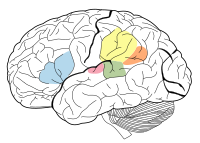
Photo from wikipedia
Abstract Parent–child language interaction in early childhood carries long-term implications for children's language and reading development. Conversational interaction, in particular, has been linked to white matter organization of neural pathways… Click to show full abstract
Abstract Parent–child language interaction in early childhood carries long-term implications for children's language and reading development. Conversational interaction, in particular, has been linked to white matter organization of neural pathways critical for language and reading. However, shared book reading serves an important role for language interaction as it exposes children to sophisticated vocabulary and syntax. Despite this, it remains unclear whether shared reading also relates to white matter characteristics subserving language and reading development. If so, to what extent do these environmentally associated changes in white matter organization relate to subsequent reading outcomes? This longitudinal study examined shared reading and white matter organization in kindergarten in relation to subsequent language and reading outcomes among 77 typically developing children. Findings reveal positive associations between the number of hours children are read to weekly (shared reading time) and the fractional anisotropy of the left arcuate fasciculus, as well as left lateralization of the superior longitudinal fasciculus (SLF). Furthermore, left lateralization of the SLF in these kindergarteners is associated with subsequent reading abilities in second grade. Mediation analyses reveal that left lateralization of the SLF fully mediates the relationship between shared reading time and second-grade reading abilities. Results are significant when controlling for age and socioeconomic status. This is the first evidence demonstrating how white matter structure, in relation to shared reading in kindergarten, is associated with school-age reading outcomes. Results illuminate shared reading as a key proxy for the home language and literacy environment and further our understanding of how language interaction may support neurocognitive development.
Journal Title: Journal of Cognitive Neuroscience
Year Published: 2022
Link to full text (if available)
Share on Social Media: Sign Up to like & get
recommendations!